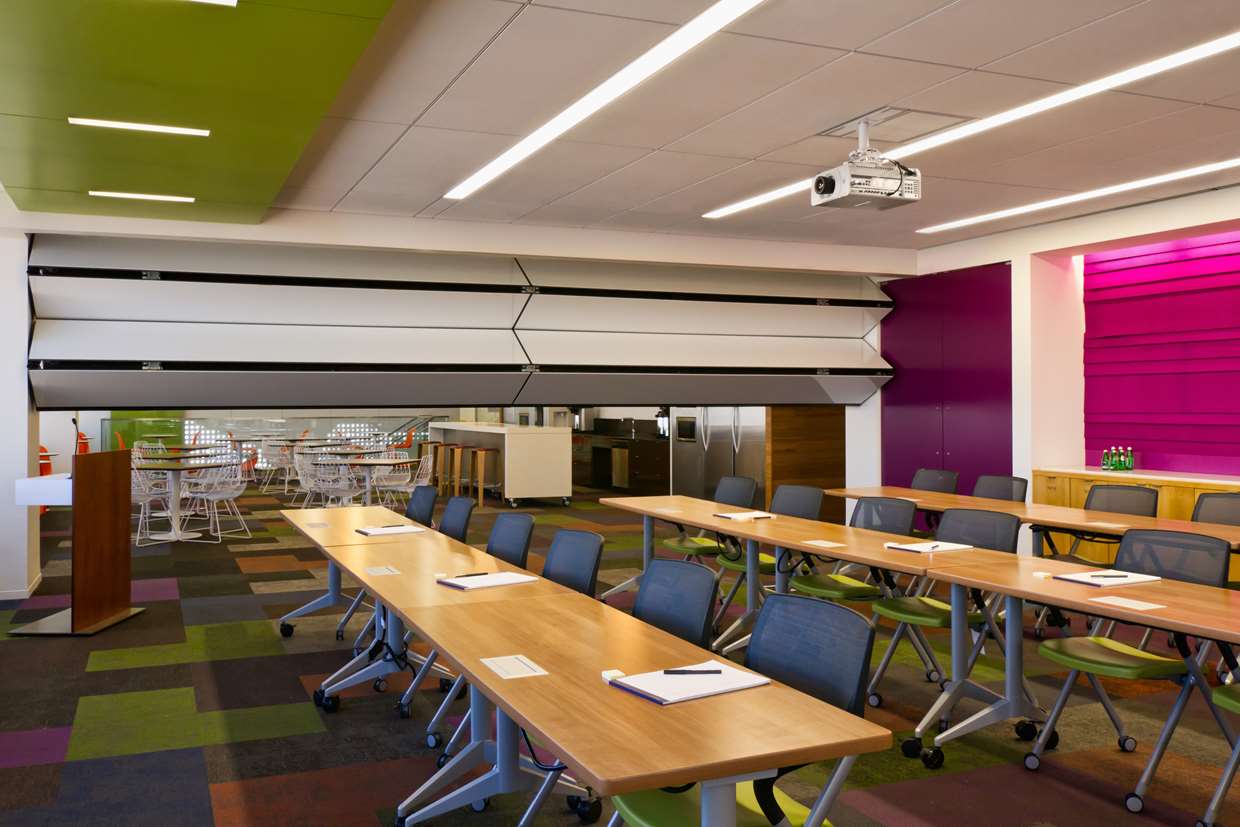Energy, Emissions, Effluents & Waste
10 minWe aim to reduce our customers’ environmental burdens by designing material- and energy-efficient products.
Read about how Skyfold and Modernfold publish Environmental Product Declarations for full product portfolios.
Read storyWhy it matters
In terms of primary energy consumption, the building sector is one of the largest energy users in the world – as a result, their influence on climate change is enormous. As a leading manufacturer, dormakaba is committed to incorporating the latest product life cycle approaches and environmental technologies to continuously advance our product development and improve our as well as our customers’ sustainability performance. This not only provides new opportunities for our design and manufacturing processes; it addresses our customers’ expectations regarding environmentally friendly products.
Key activities
We aim to reduce our customers’ environmental impacts by designing material- and energy-efficient products. We are dedicated to producing high-quality and reliable products and solutions, while also integrating our customers’ desire for environmentally friendly options. As a result, product design remains a core focus of our sustainability strategy, with an emphasis on energy consumption and carbon emissions during the product's use phase, and waste management and recyclability at its end of life.
The trend toward sustainable design and ecodesign is here to stay. With an average lifespan of 40 to 50 years, buildings should ideally be constructed in a way that allows required materials and natural resources to be used efficiently. Green Building certification schemes – such as Leadership in Energy and Environmental Design (LEED) or the German Sustainable Building Council (Deutsche Gesellschaft für Nachhaltiges Bauen, DGNB) – rate the sustainability of an entire building. The green building market is forecast to experience a CAGR of more than 10% from 2018 to 2023. By developing sustainable products and providing transparency on our sustainability performance, dormakaba secures our market position and offers added value to customers seeking Green Building certifications.
To reduce product-related energy consumption, emissions, effluents and waste, dormakaba focuses on three areas:
- Product design with a life cycle approach
- Greater transparency with Life Cycle Assessments and Environmental Product Declarations
- Sustainability platforms for greater information sharing
Product design with a life cycle approach
Our sustainability commitment and life cycle approach is integrated into the company’s Product Design Manual, which is binding for all new dormakaba-branded products in the Access Solution segments. By integrating life cycle thinking in the Product Design Manual, dormakaba is taking the first steps in integrating environmental impacts into our decision-making, as well as in product and process development. This product development and design process requires Aesthetic Design Approvals, so-called ADECO, to ensure our design integrity. Each step in our design development stage requires close collaboration between our engineers and producers. Final approval for preproduction is granted by Operations, Product Development, Product Management and Product Design. The manual’s product design requirements are binding for all new dormakaba-branded products and product ranges. The life cycle approach covers the complete value chain from resources, production and distribution to use and waste/recycling:
Greater transparency with Life Cycle Assessments and Environmental Product Declarations
Life Cycle Assessments (LCA) provide a reliable calculation of the environmental performance of a product. This includes the systematic assessment of the environmental impacts arising during the extraction of raw material through the production, distribution, and use phases which are quantified based on materials, energy consumption, transport routes, emissions, and the lifespan of the products.
dormakaba uses two LCA approaches: cradle-to-gate and cradle-to-grave. The first approach considers all production stage modules: raw material supply, transport, and manufacturing. The latter one covers all life cycle modules, which means that in addition to the cradle-to-gate stages, cradle-to-cradle analyzes the building construction process, product use stage and end of life, i.e., our upstream value chain. We mainly use cradle-to-gate “with options” so that we can select the relevant upstream life cycle module(s).
We quantify and disclose a product’s environmental impact through its entire life cycle in our Environmental Product Declarations (EPDs), which are based on the international standards ISO 14025, 14040, 14044 and the European Standard EN 15804. We have adopted them to ensure that our environmental information is reliable and credible. Our goal is that by the end of the financial year 2020/21, products representing 30% of our total turnover have EPDs and/or Health-related Product Declarations (HPDs). To provide this range of EPDs, we are working with sustainability consultancies who help us in creating the LCAs.
In addition, dormakaba has become a partner in the “Live LCA” project hosted by KIC InnoEnergy and the European Institute of Innovation and Technology. The project aims to quickly assess life cycle information by increasing the use of live data from production monitoring systems. We support the project by providing manufacturer-specific data. In addition to the LCA, product-specific live data on topics such as energy and material consumption can be used to determine potentials in energy savings or waste reduction. A key focus of the project in the 2019/20 financial year was on software development, which resulted in the beta module “iPoint Product Sustainability”. The cloud-based web application helps to identify hotspots along the life cycle where the biggest improvements can be made. The user interface is tailored to the needs of the user’s role, whether engineers or sustainability managers, in such a way that even non-LCA experts can easily understand how material choice, for example, affects the environmental impact during the product’s lifetime. dormakaba tested and gave feedback to the system’s user interface as part of the collaboration.
Sustainability platforms for greater information sharing
Product information from EPDs, HPDs and Declare Labels can contribute to the Building Information Modelling (BIM) and specifications or help attain the highest levels of green building certification systems, such as Leadership in Energy and Environmental Design (LEED).
dormakaba publishes the product information from such product declarations on internationally recognized sustainability platforms such as the DGNB Navigator, mindful MATERIALS, and the International Living Future Institute (ILFI). These databases provide transparent environmental and health information for users and ensure easy access to specific product data. By providing product information on such databases, we seek to lower market entry barriers in the green building industry, making our inclusion in related bidding processes possible. These databases serve slightly different purposes:
- DGNB Navigator is an online database created for building products based on the DGNB certification system. The online platform creates transparency and provides manufacturers, architects, planners, craftsmen and auditors with fast, precise and free valuable information on the product they are looking for and its characteristics – for example, information on environmental impacts, life cycle costs, energy requirements or emission behavior. dormakaba received DGNB-Navigator Labels for the TS 98 XEA slide channel door closer and the sensor barriers Argus 40, 60 and 80 in the financial year 2019/20.
- mindful MATERIALS is a free platform with aggregated information on environmental impacts and human health for building products. dormakaba uses it to meet international market requirements, which are mainly driven by the American construction industry, and to keep abreast of new developments. Since this platform is constantly being revised, a Content Working Group was set up, of which dormakaba is a member. The aim of the Content Working Group is to coordinate a suitable approach for product manufacturers and to make suggestions for further platform developments. dormakaba participates in bimonthly meetings with members of the Content Working Group such as architects, service providers, planners and manufacturers in order to agree on information requirements for various criteria that are included in the mindful MATERIALS Library.
- International Living Future Institute (ILFI) offers a publishing depository for Declare Labels based on the toxnot platform for chemical management and hazard assessment. dormakaba uses the toxnot platform to create and manage Declare Labels in order to fulfill the American and international market demands for greater transparency of hazard profiles. The aim of toxnot is to promote safe and environmentally friendly products. Our portfolio of seven Declare Labels was renewed in the financial year 2019/20.
Our performance
The know-how we have acquired over the years enables dormakaba to set appropriate priorities in a constantly changing international market environment with ever new demands on sustainability issues. At the same time, this evolving marketplace remains our biggest challenge. We constantly exchange knowledge with our colleagues worldwide in order to remain abreast of customer demands and to raise awareness on the importance of achieving a comprehensive understanding of sustainability issues.
We have been publishing LCAs in the form of EPDs since 2011. The first EPD we offered to customers was for our main door closer TS 93. Since then, our EPD portfolio has steadily expanded for our top-selling and tender-relevant products.
Our aim for the financial year 2019/20 was to publish 4 new EPDs. In fact, we published 13 EPDs, including for the full product lines of the room-partitioning systems of our Skyfold (3) and Modernfold (7) brands (Segment Key & Wall Solutions). EPDs were also published for the TS 98 XEA door closer, its accessories and the Argus sensor barriers. Our further aim to renew the EPD for the TS 93 was also achieved, and the renewal for the BTS 80/BTS 80 EMB/RTS 80 EMB door closers is expected in the financial year 2020/21.
These efforts contribute to achieving the dormakaba sustainability target of having EPDs and/or HPDs for products representing 30% of total annual revenue by the end of the financial year 2020/21. Currently 19% of our products based on sales volumes are covered by EPDs and/or HPDs. In order to achieve our target by the deadline, we have initiated a Group-wide project to set up a LCA tool solution for semi-automated EPD generation, which will give us the possibility to generate a larger number of EPDs in a more flexible and less resource-intensive way.
Outlook
We will continue the integration of further product clusters in the new LCA tool in the financial year 2020/21, which will enable us to develop EPDs for over 30 products. In parallel, EPDs for another 11 products, which were already in the pipeline, will be developed outside of the LCA tool. Additionally, four renewals for series of floor spring and transom door closers are also expected in the financial year 2020/21.
Skyfold and Modernfold publish Environmental Product Declarations for full product portfolios

To make sustainable decisions when building or renovating a space, architects, general contractors and business owners need to know how the products or materials selected impact the natural environment. The same goes for companies looking to expand on their sustainability initiatives, such as Skyfold and Modernfold, brands within our Key & Wall Solutions segment, manufacturing horizontally and vertically folding and acoustic automated movable walls for flexible offices, educational facilities, hospitality venues and convention centers worldwide. In their Environmental Product Declarations (EPDs), Skyfold and Modernfold share their products’ environmental performance with the aim to not only provide specifiers with the resources needed to facilitate green building certification, but also to provide themselves with a tool to reflect on their own environmental footprint.
EPDs communicate an unbiased and transparent view into how a product can impact the environment and to what extent, giving Skyfold and Modernfold a unique opportunity to assess the materials and procedures used to fabricate their movable walls, the transportation methods used to deliver these walls to customers, and different end-of-life possibilities. “What’s great about EPDs is that they provide us with a chance to reflect on our processes and products and then evaluate where and how we can improve to make Skyfold an even greener flexible space solution for our customers and our natural environment,” explains Stephan Acolatse, Engineering Supervisor and head of the team of engineers responsible for the EPD reports at Skyfold (pictured left). “It’s insightful for us as engineers and innovators, while demonstrating our commitment to be a responsible business.”
